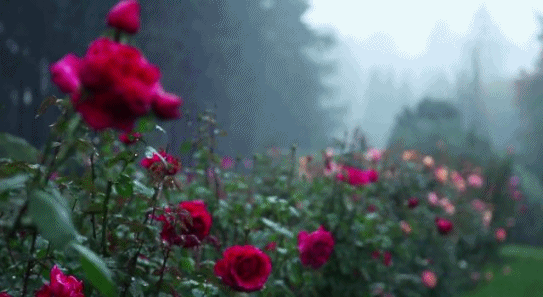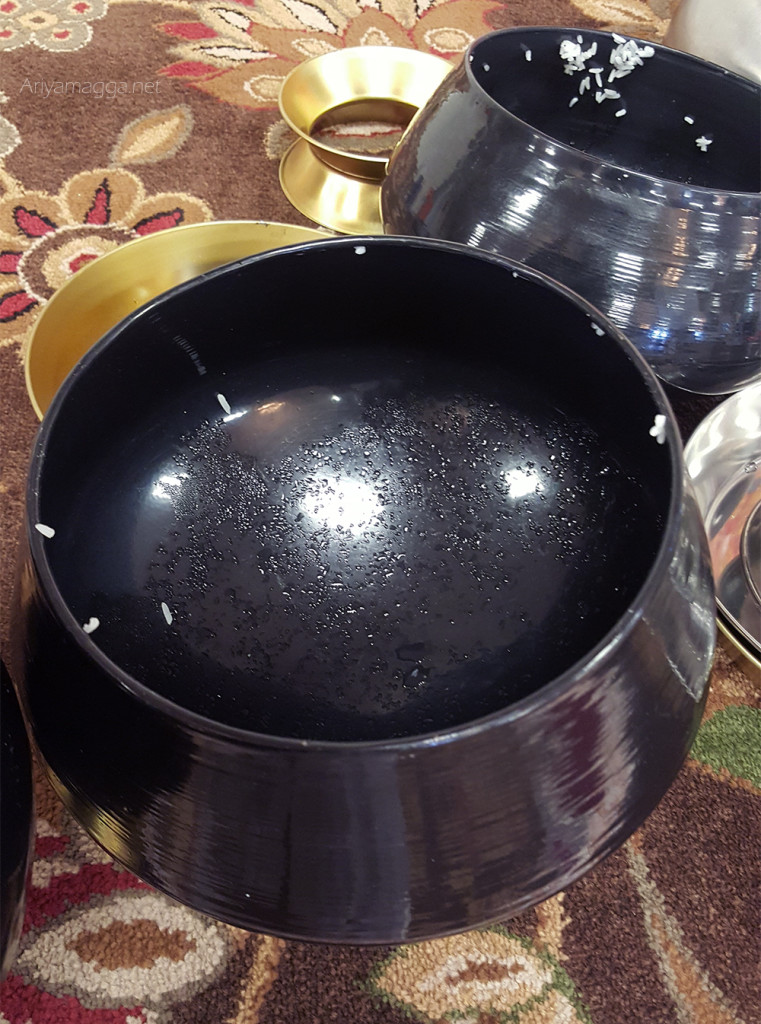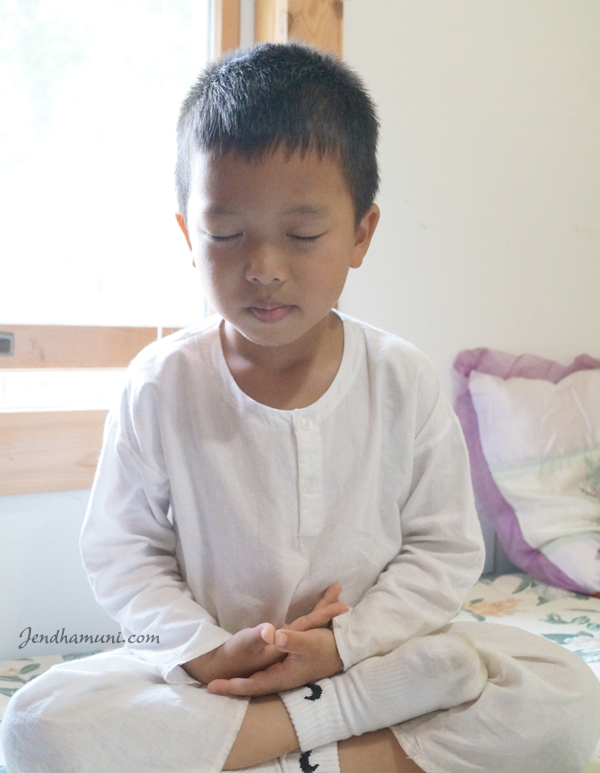-
Comment October 28, 2015
-
Depend on your mindfulness
Comment October 28, 2015If I offer you a freshly picked tangerine to enjoy, I think the degree to which you enjoy it will depend on your mindfulness. If you are free of worries and anxiety, you will enjoy it more. If you are possessed by anger or fear, the tangerine may not be very real to you. ~Thich Nhat Hanh

-
The word “suchness”
Comment October 28, 2015In Buddhism, the word “suchness” is used to mean “the essence or particular characteristics of a thing or a person, its true nature.” Each person has his or her suchness. If we want to live in peace and happiness with a person, we have to see the suchness of that person. ~Thich Nhat Hanh

RFA photo
-
Your first love
Comment October 28, 2015Your first love has no beginning or end. Your first love is not your first love, and it is not your last. It is just love. It is one with everything. ~Thich Nhat Hanh

-
On Meditation
Comment October 28, 2015A Dhamma talk by Ajahn Chah
To calm the mind means to find the right balance. If you try to force your mind too much it goes too far; if you don’t try enough it doesn’t get there, it misses the point of balance.
Normally the mind isn’t still, it’s moving all the time. We must strengthen the mind. Making the mind strong and making the body strong are not the same. To make the body strong we have to exercise it, to push it, in order to make it strong, but to make the mind strong means to make it peaceful, not to go thinking of this and that. For most of us the mind has never been peaceful, it has never had the energy of samādhi2, so we must establish it within a boundary. We sit in meditation, staying with the ‘one who knows’.
If we force our breath to be too long or too short, we’re not balanced, the mind won’t become peaceful. It’s like when we first start to use a pedal sewing machine. At first we just practise pedalling the machine to get our coordination right, before we actually sew anything. Following the breath is similar. We don’t get concerned over how long or short, weak or strong it is, we just note it. We simply let it be, following the natural breathing.
When it’s balanced, we take the breathing as our meditation object. When we breathe in, the beginning of the breath is at the nose-tip, the middle of the breath at the chest and the end of the breath at the abdomen. This is the path of the breath. When we breathe out, the beginning of the breath is at the abdomen, the middle at the chest and the end at the nose-tip. Simply take note of this path of the breath at the nosetip, the chest and the abdomen, then at the abdomen, the chest and the tip of the nose. We take note of these three points in order to make the mind firm, to limit mental activity so that mindfulness and self-awareness can easily arise.
When our attention settles on these three points, we can let them go and note the in and out breathing, concentrating solely at the nose-tip or the upper lip, where the air passes on its in and out passage. We don’t have to follow the breath, just to establish mindfulness in front of us at the nose-tip, and note the breath at this one point – entering, leaving, entering, leaving. Continue reading
-
The Story of Devadatta
Comment October 28, 2015
Verse 9: He who is not free from taints of moral defilements (kilesas) and yet dons the yellow robe, who lacks restraint in his senses and (speaks not the) truth is unworthy of the yellow robe.
Verse 10: He who has discarded all moral defilements (kilesas), who is established in moral precepts, is endowed with restraint and (speaks the) truth is, indeed, worthy of the yellow robe.
1. kasavam or kasavam vattham: the yellow or reddish yellow robe donned by members of the Buddhist Religious Order. There is a play on words in the above stanzas; ‘anikkasavo’, meaning, not free from faults of moral defilements and therefore, stained; and kasavam, the yellow robe, dyed sombre in some astringent juice and is therefore stained.
2. vantakasav’assa: lit., has vomited all moral defilements; it means, has discarded all moral defilements through the four Path Knowledge (Magga nana).
While residing at the Jetavana monastery in Savatthi, the Buddha uttered Verses (9) and (10) of this book, with reference to Devadatta.
Once the two Chief Disciples, the Venerable Sariputta and the Venerable Maha Moggallana, went from Savatthi to Rajagaha. There, the people of Rajagaha invited them, with their one thousand followers, to a morning meal. On that occasion someone handed over a piece of cloth, worth one hundred thousand, to the organizers of the alms-giving ceremony. He instructed them to dispose of it and use the proceeds for the ceremony should there be any shortage of funds, or if there were no such shortage, to offer it to anyone of the bhikkhus they thought fit. It so happened that there was no shortage of anything and the cloth was to be offered to one of the theras. Since the two Chief Disciples visited Rajagaha only occasionally, the cloth was offered to Devadatta, who was a permanent resident of Rajagaha.
Devadatta promptly made the cloth into robes and moved about pompously, wearing them. Then, a certain bhikkhu from Rajagaha came to Savatthi to pay homage to the Buddha, and told him about Devadatta and the robe, made out of cloth worth one hundred thousand. The Buddha then said that it was not the first time that Devadatta was wearing robes that he did not deserve. The Buddha then related the following story.
Devadatta was an elephant hunter in one of his previous existences. At that time, in a certain forest, there lived a large number of elephants. One day, the hunter noticed that these elephants knelt down to the paccekabuddhas* on seeing them. Having observed that, the hunter stole an upper part of a yellow robe and covered his body and hand with it. Then, holding a spear in his hand, he waited for the elephants on their usual route. The elephants came, and taking him for a paccekabuddha fell down on their knees to pay obeisance. They easily fell prey to the hunter. Thus, one by one, he killed the last elephant in the row each day for many days.
The Bodhisatta (the Buddha-to-be) was then the leader of the herd. Noticing the dwindling number of his followers he decided to investigate and followed his herd at the end of the line. He was alert, and was therefore able to evade the spear. He caught hold of the hunter in his trunk and was about to dash him against the ground, when he saw the yellow robe. Seeing the yellow robe, he desisted and spared the life of the hunter.
The hunter was rebuked for trying to kill under cover of the yellow robe and for commuting such an act of depravity. The hunter clearly did not deserve to put on the yellow robe.
Then the Buddha spoke in verse as follows:
Verse 9: He who is not free from taints of moral defilements (kilesas) and yet dons the yellow robe, who lacks restraint in his senses and (speaks not the) truth is unworthy of the yellow robe.
Verse 10: He who has discarded all moral defilements (kilesas), who is established in moral precepts, is endowed with restraint and (speaks the) truth is, indeed, worthy of the yellow robe.
At the end of the discourse, many bhikkhus were established in Sotapatti Fruition.
* Paccekabuddha: One who, like the Buddha, is Self-Enlightened in the Four Noble Truths and has uprooted all the moral defilements (kilesas). However, he cannot teach others. Paccekabuddhas appear during the absence of the Buddha Sasana (Teaching).
Dhammapada Verses 9 and 10
Devadatta VatthuAnikkasavo kasavam1
yo vattham paridahissati
apeto damasaccena
na so kasavamarahati.Yo ca vantakasav’assa2
silesu susamahito
upeto damasaccena
sa ve kasavamarahati.Source: Tipitaka
-
Smiling is very important
Comment October 26, 2015Smiling is very important. If we are not able to smile, then the world will not have peace.
To dwell in the here and now does not mean you never think about the past or responsibly plan for the future. The idea is simply not to allow yourself to get lost in regrets about the past or worries about the future. If you are firmly grounded in the present moment, the past can be an object of inquiry, the object of your mindfulness and concentration. You can attain many insights by looking into the past. But you are still grounded in the present moment. ~Thich Nhat Hanh
-
The Story of Dhammika Upasaka
Comment October 26, 2015
Verse 16: Here he rejoices, hereafter he rejoices; one who performed meritorious deeds rejoices in both existences. He rejoices and greatly rejoices when he sees the purity of his own deeds.
While residing at the Jetavana monastery in Savatthi, the Buddha uttered Verse (16) of this book, with reference to Dhammika, a lay disciple.
Once there lived in Savatthi, a lay disciple by the name of Dhammika, who was virtuous and very fond of giving in charity. He generously offered food and other requisites to the bhikkhus regularly and also on special occasions. He was, in fact, the leader of five hundred virtuous lay disciples of the Buddha who lived in Savatthi. Dhammika had seven sons and seven daughters and all of them, like their father, were virtuous and devoted to charity. When Dhammika was very ill and was on his death-bed he made a request to the Samgha to come to him and recite the sacred texts by his bedside. While the bhikkhus were reciting the Maha satipatthana Sutta, six decorated chariots from six celestial worlds arrived to invite him to their respective worlds. Dhammika told them to wait for a while for fear of interrupting the recitation of the Sutta. The bhikkhus, thinking that they were being asked to stop, stopped and left the place.
A little while later, Dhammika told his children about the six decorated chariots waiting for him. Then and there he decided to choose the chariot from the Tusita world and asked one of his children to throw a garland on to it. Then he passed away and was reborn in the Tusita world. Thus, the virtuous man rejoices in this world as well as in the next.
Then the Buddha spoke in verse as follows:
Verse 16: Here he rejoices, hereafter he rejoices; one who performed meritorious deeds rejoices in both existences. He rejoices and greatly rejoices when he sees the purity of his own deeds.
Dhammapada Verse 16
Dhammika-upasaka VatthuIdha modati pecca modati
katapunno ubhayattha modati
so modati so pamodati
disva kammavisuddhimattano.Source: Tipitaka
-
Essence
Comment October 26, 2015Those who regard
non-essence as essence
and see essence as non-,
don’t get to the essence,
ranging about in wrong resolves.
But those who know
essence as essence,
and non-essence as non-,
get to the essence,
ranging about in right resolves.~Dhammapada

RFA photo/Hang Savyouth
-
The obstacle of Knowledge
227 October 26, 2015If we are caught by the obstacle of knowledge, even if truth comes knocking at our door, we will refuse to let it in. ~Thich Nhat Hanh






